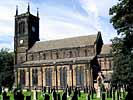 Lenton Lenton
Holy Trinity
History
The foundation stone of Holy Trinity church was laid on 11 June 1841 by Francis Wright of Lenton Hall who donated half the cost of building (£6,000) as well as the land for the church, burial ground, vicarage and schools. It was built on a greenfield site in what was then the developing district of New Lenton. The architect was H. I. Stevens of Derby.
The church was consecrated by the Bishop of Lincoln, the Right Rev. John Jackson, on 6 October 1842.
A clock was installed in the tower in 1844. By the close of the 19th century it was illuminated, and in connection with the bells played the Cambridge chimes at the hours and quarters.
Although there is no return for Holy Trinity church in the 1851 national religious census it does state that the parish covered 5,800 acres of land and had a population of 4,527 people. The parish at this point included the settlements of Old and New Lenton, Hyson Green (where the chapel-of-ease of St Paul was built in 1844) and all the land now occupied by the University of Nottingham Campus. The land was originally part of the former estate of the Lenton Priory. Over time a considerable amount of housing and commercial development took place within the parish and new parishes were formed as the population expanded.
Originally the church had only one bell but in 1856 five additional bells cast by Taylor & Co. of Loughborough were installed in the tower thanks to the generosity of John Shaw, one of the churchwardens.
For the first 20 years the east end of the chancel was partitioned off and used as a vestry but in 1862 it was taken down and a new vestry built on the south side of the chancel. The removal of the partition exposed the reredos, erected in 1858 at a cost of £43. The reredos was of Ancaster stone with the Agnus Dei carved in the centre. Several years later, in 1870, an organ chamber was built on the north side of the chancel and the organ moved to here from the gallery.
In 1873 a stained glass window in memory of Francis Wright, church founder and benefactor, was installed in the east window of the chancel. The memorial window contains ‘conventional floral devices in brilliant colours.’
The original pulpit was very high, commonly called a ‘two-decker,’ with a reading desk underneath. In 1882 this was removed and sold to the Primitive Methodists and installed in their chapel on Abbey Street. The replacement ironwork pulpit was itself replaced in 1894.
A programme of restoration under the architects Evans and Jolley of Nottingham started in 1893. The work included reseating the western gallery to make it suitable for adults, thoroughly cleaning and restoring the interior and repairing exterior ironwork such as railings and doors, and reseating and re-arranging the chancel. Wood and glass lobbies were erected to form an entrance to the church, the font was moved to the west end of the south aisle, the chancel repaved with tiles and refitted with new stalls, a low stone screen added between the nave and chancel and new choir and clergy vestries provided: prior to this the clergy were forced to use the recess behind the organ. The Lord Bishop of Southwell reopened the church on 5 April 1894.
The records of the parochial visitation by the Bishop of Southwell, Edwyn Hoskins, in 1911 state that the parish population had increased to 12,390 despite a reduction in the area covered by Holy Trinity’s parish. The visitation report also states that the Sunday School attracted 1,174 children, whilst the day school had 629 scholars, and the church was very active with 112 baptisms and 54 confirmations performed in the previous year.
In 1911 the reredos installed in 1858 was replaced by one donated by W. G. Player. He also gifted the carved wooden rood screen erected in 1931.
‘Extensive internal repairs and decoration’ were undertaken during the summer of 1935. In addition, a number of principal timbers were found to be in very poor condition and were replaced. The renovated church was reopened by the vicar, the Rev R. J. R. Skipper, on 26 September 1935.
Examples of the devolution of the parish land continued, and in 1938 the daughter church of St. Mary, Wollaton Park was opened, becoming a church in its own right in 1956. Also in 1938 another daughter church, St. Barnabas in Lenton Abbey was dedicated, eventually becoming independent in 1955.
The church site also accommodates a large brick-built vicarage located to the east of the church, conveniently connected by a path. It is now called Unity House and is partially used by the church as an office with other areas converted to apartments. The vicar is now accommodated in a modern house set in part of the old vicarage grounds.
Extensive dry rot was found in 2013 and the church was closed in August 2014. The roof was then stripped, roof timbers infected by dry rot repaired, slates replaced and re-laid, and gutters reformed. Holy Trinity re-opened on 11 June 2016.
The baptism, marriage and burial records of the church are held by Nottinghamshire Archives.
| 




